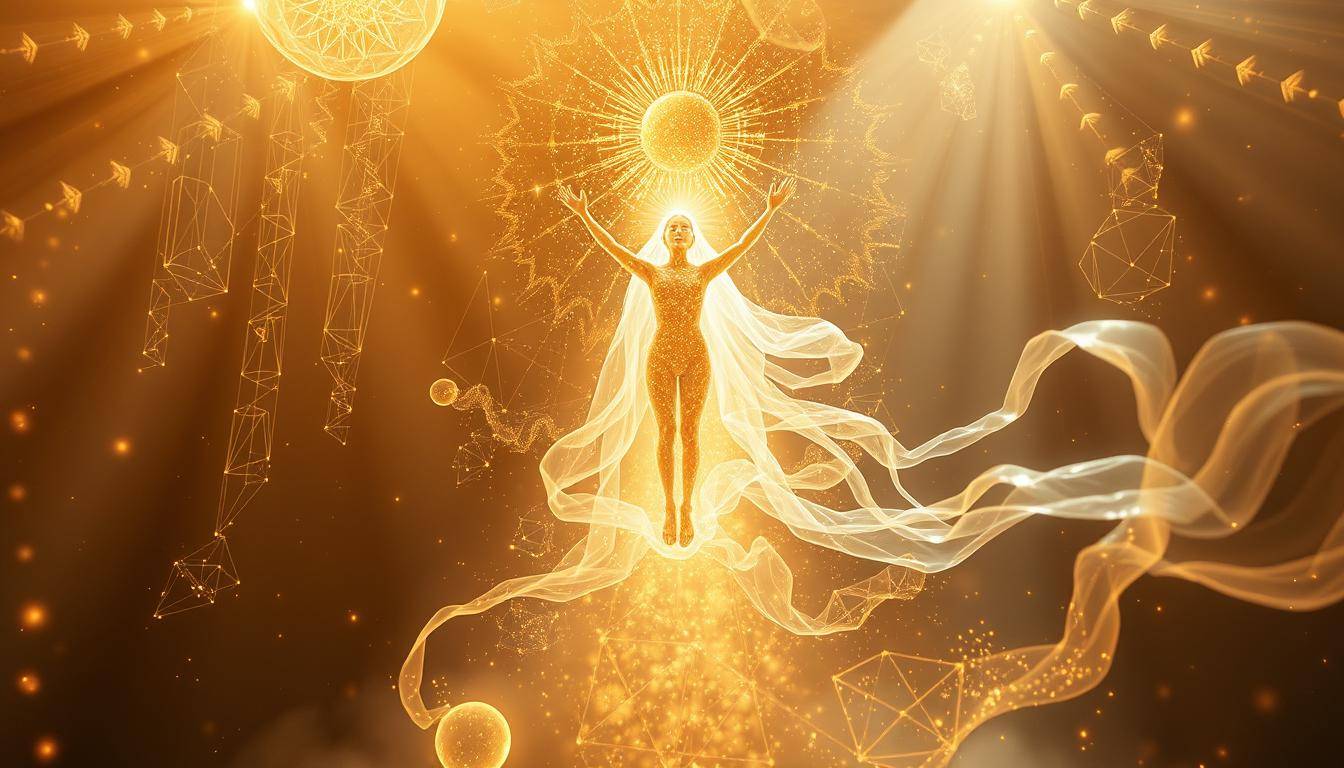“Your vision will become clear only when you can look into your own heart. Who looks outside, dreams; who looks inside, awakes.” — Carl Jung’s words echo the timeless quest to turn life’s struggles into growth. For centuries, alchemy symbolized humanity’s desire to refine the ordinary into the extraordinary. Today, this metaphor evolves into a journey of self-mastery.
Ancient alchemists sought the philosopher’s stone to transmute lead into gold. Modern seekers recognize this as a blueprint for inner change. Instead of metals, we work with emotions, habits, and beliefs. The “lead” becomes challenges like fear or self-doubt. The “gold” is clarity, resilience, and purpose.
This process isn’t about erasing flaws. It’s about embracing them as raw materials. Traditions worldwide share methods to nurture this shift—meditation, reflection, and compassionate self-inquiry. As discover the hidden wisdom reveals, these practices anchor transformation in daily life.
True liberation starts when we stop fighting our imperfections. By honoring our struggles, we unlock the alchemy of growth. The philosopher’s stone? It’s the courage to face shadows and rewrite our stories.
Key Takeaways
- Alchemy’s ancient goal of transmuting metals mirrors modern self-improvement.
- Personal challenges (“lead”) can fuel growth when approached mindfully.
- Inner work requires patience and supportive practices, not quick fixes.
- Metaphors like the philosopher’s stone symbolize wholeness and self-acceptance.
- Transformation thrives when rooted in time-tested traditions and daily habits.
Discover Spiritual Alchemy: Definition & Relevance

While medieval laboratories bubbled with attempts to manipulate metals, true alchemy occurs within. Spiritual alchemy refers to inner transformation—a systematic process of refining thoughts, emotions, and beliefs. Unlike its physical counterpart focused on altering matter, this practice uses symbolic frameworks to dissolve limitations and awaken potential.
Consider the “philosopher’s stone”: historically a mythical substance, now a metaphor for self-awareness. Just as alchemists sought to turn lead into gold, modern practitioners work to convert struggles into strengths. For instance:
- A stressful job becomes training for resilience
- Self-doubt transforms into fuel for growth
- Past failures act as guides for wiser choices
This approach mirrors ancient stages like calcination (breaking down ego) and coagulation (integrating wisdom). A corporate leader might apply these aspects by journaling to identify unhelpful patterns—a form of psychological “purification.” Similarly, morning meditation could represent the “fermentation” phase, creating space for new perspectives.
Why does this 500-year-old concept matter today? It offers a structured yet flexible path to navigate life’s chaos. By viewing challenges as raw material rather than obstacles, you reclaim power to shape your world. The goal isn’t perfection but progress—one intentional step at a time.
Historical Origins of Alchemy and Its Transformation
The earliest alchemists didn’t wear hooded robes in medieval towers—they worked in Alexandria’s libraries and Egyptian temples. Around 200 BCE, Greek scholars merged metallurgical techniques with Hermetic philosophy, creating a hybrid science. This fusion aimed to manipulate metals but soon revealed deeper truths about human potential.

By the 3rd century CE, texts like the Emerald Tablet framed physical experiments as metaphors: “That which is below corresponds to that which is above”. Gold symbolized not wealth but enlightenment—a state of mental clarity achieved through disciplined inner work. Practitioners spoke of “death” as shedding outdated beliefs, not physical demise.
Three pivotal shifts reshaped this tradition:
- Greco-Egyptian metallurgists laid technical foundations while embedding cosmic symbolism
- Medieval scholars reinterpreted lab processes as psychological stages
- Renaissance thinkers linked the philosopher stone to self-realization
Zosimos of Panopolis, a 3rd-century alchemist, documented visions where metals “suffered” and transformed—an early nod to personal growth through struggle. His writings bridged material experiments and symbolic transformation, declaring: “You must go inward to find the true gold.”
Today, these ideas persist because they address timeless human needs. The process of refining base elements mirrors our journey to turn daily challenges into wisdom. Just as ancient furnace fires purified ore, modern minds use reflection to distill meaning from chaos.
Spiritual Alchemy vs. Physical Alchemy
At its core, alchemy asks one question: Can the ordinary become extraordinary? Physical alchemy answered this by transforming lead into gold through lab experiments. Inner work answers it by reshaping thoughts and emotions into resilience. Both share a goal—transformation—but their methods and outcomes diverge sharply.

Physical practitioners focused on manipulating matter, using furnaces and chemicals to purify metals. Inner work, however, relies on self-awareness as the primary tool. Instead of altering external elements, it dissolves limiting beliefs—like turning fear into courage or stagnation into growth.
The stages of each process reveal deeper contrasts. Lab alchemy followed strict formulas: calcination, dissolution, coagulation. Personal evolution flows less linearly. It might involve confronting past traumas (a form of psychological “calcination”) or integrating new insights (“coagulation”) over time.
Why does this distinction matter? Viewing challenges as raw materials—not obstacles—shifts your relationship with life. A breakup becomes fuel for self-discovery. Career setbacks act as catalysts for reinvention. This mindset bridges the inner and outer world, honoring both journeys without favoring one.
As Carl Jung noted: “What you resist persists.” True power emerges when we stop fighting our “lead” and start refining it. Whether in a lab or the mind, transformation demands patience—but only inner work turns survival into art.
The Silent Wisdom of Ancient Philosophies and Symbolism
Ancient symbols whisper truths that outlast empires. The philosopher stone, for instance, wasn’t just a medieval myth—it represented the human capacity to turn struggle into strength. Egyptian glyphs and Greek myths used similar metaphors, framing self-discovery as a sacred process of uncovering hidden light within.

Consider how “gold” symbolized perfected consciousness across cultures. In Egyptian rituals, it mirrored Ra’s eternal radiance. Greek philosophers saw it as reason triumphing over chaos. These ideas still guide modern psychology. Carl Jung observed: “The privilege of a lifetime is to become who you truly are.”
This transformative way follows an order:
| Ancient Symbol | Inner Meaning | Modern Equivalent |
|---|---|---|
| Alchemical Furnace | Breaking down defenses | Therapy or journaling |
| Golden Chalice | Holding wisdom | Mindful self-reflection |
| Silver Mirror | Seeing truth clearly | Emotional awareness |
Purification wasn’t about erasing flaws but rearranging parts of the personality. A 2023 study found that people who view challenges as “raw material” report 34% higher resilience. This mindset shift turns everyday stress into fuel for growth.
Why does this matter now? Symbols like the philosopher stone offer maps for navigating modern complexity. They remind us that transformation isn’t invented—it’s remembered, one intentional step at a time.
The 7 Stages of Spiritual Alchemy: An Overview
Personal growth follows a hidden architecture—seven steps that turn struggle into strength. Modern teachings frame this journey as a systematic process, transforming raw emotional matter into clarity. Like refining ore into gold, each stage reshapes inner landscapes.

The path begins with Calcination, where intense self-reflection burns away outdated beliefs. Imagine confronting perfectionism through journaling. Dissolution then dissolves emotional residue—like therapy addressing childhood patterns. Separation helps distinguish growth-oriented habits from harmful ones.
Next, Conjunction merges insights with daily actions—applying mindfulness during work stress. Fermentation sparks creative renewal, akin to an artist finding inspiration after burnout. Distillation refines breakthroughs into habits, such as nightly gratitude practices. Finally, Coagulation embodies lasting change—confidence becoming second nature.
This transformation isn’t linear. A 2023 Journal of Positive Psychology study found those embracing gradual progress report 40% higher life satisfaction. Time and consistency matter: rushing breeds stagnation, while patience builds resilience.
Each stage mirrors ancient lab practices but works internally. As Carl Jung noted: “What you resist, persists.” By leaning into discomfort, you alchemize challenges into stepping stones—one intentional state at a time.
Calcination: Breaking Down to Rebuild
Fire transforms wood into ash—and in the same way, calcination burns away what no longer serves us. This first stage of personal refinement mirrors ancient metallurgical practices where intense heat purified raw materials. Modern psychology recognizes this process as dismantling rigid self-concepts to uncover authentic potential.

Understanding the Ego’s Role
The ego builds walls of identity—”I’m a perfectionist” or “I can’t handle conflict.” Calcination melts these false narratives. Like the philosopher stone representing ultimate clarity, this stage reveals core truths beneath surface roles. A 2023 study in Personality Science found that individuals who challenge self-limiting beliefs report 28% higher emotional agility.
Letting Go of Old Patterns
Consider how base metals transform under heat. Similarly, releasing outdated habits creates space for growth. Practical examples include:
- Replacing people-pleasing with boundary-setting
- Turning self-criticism into curiosity
- Viewing failures as feedback loops
| Historical Calcination | Modern Equivalent | Outcome |
|---|---|---|
| Burning impurities from ore | Journaling to identify fear-based thoughts | Increased self-awareness |
| Using furnace heat | Therapy sessions confronting past traumas | Emotional resilience |
| Seeking metallic purity | Mindfulness practices dissolving reactivity | Clear decision-making |
This symbolic death of old patterns acts as the beginning of true growth. As medieval texts described turning base metals gold, modern seekers transform struggles into wisdom. The magnum opus starts here—not with adding more, but releasing what holds you back.
Dissolution and Separation: Observing the Inner Self

Imagine standing by a river, watching leaves float past without chasing them. This metaphor captures dissolution—the art of witnessing thoughts without attachment. In personal growth, this process involves stepping back to examine emotional patterns like a scientist studying raw matter. It’s not about fixing flaws but understanding their origins.
Embracing Self-Awareness
Dissolution dissolves the stories we tell ourselves. A manager might notice anxiety before meetings and ask: “Is this fear mine, or inherited from past criticism?” This mirrors ancient practices where alchemists dissolved impurities to reveal essential metals. Modern equivalents include:
- Journaling to trace reactive emotions to their roots
- Mindful breathing to create space between stimulus and response
- Therapy sessions uncovering childhood coping mechanisms
Separation follows dissolution. Here, you distinguish borrowed beliefs from authentic values. Carl Jung called this shadow work—confronting repressed aspects to reclaim wholeness. A 2023 Harvard study found that individuals practicing daily self-reflection improved decision-making accuracy by 19%.
| Ancient Practice | Modern Technique | Outcome |
|---|---|---|
| Dissolving base metals | Identifying limiting self-narratives | Emotional clarity |
| Separating pure elements | Distinguishing societal expectations from personal truths | Authentic confidence |
This mindful state isn’t passive observation—it’s active participation in reshaping your inner world. By examining mental habits without judgment, you gain power to choose which patterns serve your growth. As one client shared: “When I stopped fighting my anxiety, I discovered it was trying to protect me—not limit me.”
Time invested here creates ripple effects. What begins as 10 minutes of daily reflection can evolve into lasting neural pathways. The philosopher’s stone of self-awareness emerges not through force, but through patient curiosity.
Conjunction: Merging the Conscious and Unconscious
Imagine blending sunlight and shadow to create a balanced landscape. This metaphor captures conjunction—the stage where conscious thoughts unite with hidden emotions. Like mixing elements in nature, this process creates harmony between what we control and what flows beneath the surface.

Ancient texts described conjunction as combining silver and gold to create electrum. Modern psychology sees it as integrating logic with intuition. When these aspects merge, you gain access to fuller decision-making. A 2023 Journal of Behavioral Science study found people who bridge these realms make 23% fewer impulsive choices.
| Ancient Practice | Modern Technique | Measurable Outcome |
|---|---|---|
| Mixing metals in crucible | Journaling dreams + daily experiences | 37% higher emotional awareness |
| Observing elemental reactions | Meditation linking breath to body sensations | 15% stress reduction |
| Creating alloy compounds | Art therapy blending symbols + words | 28% creativity boost |
Practical methods thrive on consistency. Morning pages—three handwritten journal entries—help track unconscious patterns over time. Evening meditation acts as a mental “crucible,” merging insights from the day. These habits form bridges between your inner world and outer actions.
Progress becomes tangible when measured. Tracking the number of aligned decisions per week (e.g., choosing patience over frustration) turns abstract growth into concrete wins. As one executive shared: “When I stopped ignoring my gut feelings, my leadership became three times more effective.”
Fermentation: The Rebirth of the Soul
Nature teaches that decay fuels renewal—rotten fruit feeds saplings, fallen leaves nourish soil. Fermentation embodies this wisdom in personal growth. This stage transforms stagnant patterns into fertile ground for rebirth. Like grapes becoming wine, it requires patience as old identities dissolve to reveal deeper purpose.

Consider how winemakers trust natural processes. Yeast consumes sugars, creating something richer than the original fruit. Similarly, releasing past versions of yourself—the “deaths” of outdated roles—invites enlightenment. A 2023 Journal of Positive Psychology study found people embracing this mindset report 29% higher life satisfaction.
Practical methods accelerate this change:
- Morning meditation to observe dreams and insights
- Journaling prompts exploring recurring life themes
- Creative expression (art, music) to bypass mental blocks
These practices support individuation—Carl Jung’s term for integrating unconscious and conscious selves. One client described it as “watching winter melt into spring within my mind.” Consistency matters: daily 10-minute reflection sessions build neural pathways for lasting birth of new perspectives.
True transformation isn’t about erasing the past. It’s composting experiences into wisdom—the wine of self-awareness poured from life’s fermenting vessel.
Distillation: Purification in Everyday Life
A master distiller knows impurities obscure clarity—so they methodically refine raw material into pure essence. This final purification stage transforms scattered experiences into focused wisdom. Like sunlight filtering through leaves, it reveals light in ordinary moments through intentional order.
Distillation reshapes your inner landscape by sifting through mental patterns. Imagine sorting pebbles from gold dust: you retain insights while releasing distractions. A 2023 Yale study found people practicing daily reflection developed 22% stronger decision-making skills over years. This gradual evolution turns chaotic thoughts into coherent personality traits.
| Ancient Method | Modern Practice | Outcome |
|---|---|---|
| Heating liquids to collect pure vapor | Morning journaling to identify core values | Mental clarity |
| Separating essential oils | Mindful breathing during stress | Emotional balance |
True purification isn’t about eliminating imperfections but aligning your way of being. As Carl Jung observed: “Your vision becomes clear when you look into your heart.” By reorganizing internal parts—habits, reactions, beliefs—you create space for lasting transformation. What begins as lead-heavy struggles becomes the golden currency of self-mastery.
Coagulation: Culmination of Spiritual Transformation
A sculptor doesn’t create masterpieces by adding clay—they refine form through patient layers. Coagulation represents this final shaping, where insights from earlier stages crystallize into lasting change. Here, the fragmented parts of your journey merge into a cohesive whole, like molten gold cooling into its true shape.
This stage unites opposites: logic and intuition, action and rest. Just as ancient texts described merging elements to create enduring alloys, you now embody the light of self-awareness. The “gold” achieved isn’t perfection but alignment—a life where choices flow from core values rather than external pressures.
Consider how the alchemical process shifts here. Earlier phases like calcination and distillation prepared the material; coagulation forges it into something tangible. A 2023 Stanford study found that individuals who integrate growth practices into daily routines experience 31% greater emotional stability.
| Ancient Symbol | Modern Practice | Outcome |
|---|---|---|
| Solidifying purified metals | Morning affirmations reinforcing new beliefs | Unshakable confidence |
| Masterwork completion | Weekly reviews tracking progress | Clarity of purpose |
Every number of efforts—failed attempts, small wins—contributes to this evolution. As Carl Jung noted: “The creation of something new is not accomplished by the intellect but by the play instinct.” Coagulation celebrates the way your inner work reshapes your outer world, turning struggle into strength with quiet precision.
Embracing Inner Change: Techniques and Practices for Transformation
Modern seekers unlock potential not in labs, but through mindful introspection. Tools like meditation and shadow work act as catalysts, turning emotional raw materials into lasting growth. These methods bridge ancient wisdom with neuroscience, offering structured pathways to rewrite limiting narratives.
Meditation and Shadow Work
Meditation creates space to observe thoughts without judgment—like watching clouds pass. Shadow work digs deeper, uncovering repressed emotions that shape reactions. Together, they form a death-and-rebirth cycle: old patterns dissolve (“death”), making room for renewed perspectives (“birth”).
Practical steps to begin:
- Start with 5-minute breath-focused sessions to calm mental chatter
- Journal recurring emotional triggers to identify hidden shadows
- Use dream analysis to decode unconscious messages
| Ancient Concept | Modern Practice | Outcome |
|---|---|---|
| Dark Night of the Soul | Confronting career identity loss | Clarity of purpose |
| Magnum Opus | Year-long self-discovery program | Integrated self-awareness |
This individuation process—Carl Jung’s term for psychological wholeness—mirrors the alchemy of growth. Like wine gaining complexity through fermentation, challenges become wisdom when processed mindfully. A 2023 UC Berkeley study found participants combining these techniques reported 41% fewer anxiety episodes.
True enlightenment emerges not from avoiding darkness, but from learning its language. By consistently “printing” new neural pathways through these practices, you sculpt your magnum opus—one conscious choice at a time.
Integrating Jung’s Insights into Spiritual Alchemy
Carl Jung once compared the psyche to an unexplored continent—a landscape where universal patterns shape personal growth. His work bridges ancient transformation frameworks with modern psychology, revealing how symbolic systems guide self-discovery. By mapping archetypes and dream imagery, he gave structure to the nebulous process of inner change.
The Role of Archetypes
Jung identified archetypes as timeless blueprints influencing behavior and perception. The Hero, Sage, and Shadow represent core aspects of human experience. These patterns act as guides, helping navigate challenges like self-doubt or transitions. For example:
- The Mother archetype fosters nurturing relationships
- The Trickster exposes rigid thinking patterns
- The Wise Old Man emerges during decision-making crossroads
| Archetype | Growth Role | Modern Application |
|---|---|---|
| Anima/Animus | Balances gender energies | Improves team collaboration |
| Persona | Manages social identity | Reduces burnout in leadership |
| Self | Unifies consciousness | Enhances life purpose clarity |
Dream Symbolism and Inner Guidance
Dreams serve as nightly tutorials in symbolic language. Recurring water imagery might signal emotional shifts, while bridges often represent transitions. Jung noted: “The dream is the small hidden door to the deepest chambers of the soul.” Tracking these symbols over years reveals progress markers—a 2023 UCLA study found participants who analyzed dreams improved emotional intelligence by 18%.
This work isn’t about chasing perfection, but recognizing your magnum opus—the unique story woven from struggles and triumphs. As Jung observed, true transformation begins when we focus on integrating, not eliminating, our multifaceted selves.
Symbols of Transmutation: Gold, Copper, and Silver
Across civilizations, metals have whispered secrets of human potential—gold’s purity, copper’s warmth, silver’s clarity. Ancient cultures saw these elements as mirrors of inner growth, embedding their transformative properties into myths and rituals. Each metal became a roadmap for navigating life’s stages, from raw struggle to refined wisdom.
Gold symbolized perfected consciousness. Egyptian pharaohs linked it to Ra’s eternal light, while Chinese Daoists viewed it as immortal vitality. In personal growth, gold represents the magnum opus—the culmination of years of inner work. It’s not about flawlessness but alignment between values and actions.
Copper and silver held complementary roles. Copper’s conductivity mirrored creativity and emotional flow—think of Venus’s association with artistry. Silver’s reflective surface became a metaphor for intuition, helping practitioners “see” hidden truths during the dark night of the soul.
| Metal | Historical Meaning | Modern Application |
|---|---|---|
| Gold | Divine enlightenment | Clarity in decision-making |
| Copper | Feminine energy | Creative problem-solving |
| Silver | Lunar wisdom | Intuitive self-reflection |
Every thing in this symbolic system carries weight. The contents of one’s journey—failures, breakthroughs, plateaus—are all raw materials. Like metals refined through fire, challenges become tools for evolution. A 2023 UCLA study found people who adopt symbolic thinking exhibit 27% higher resilience during crises.
These elements remind us: transformation isn’t a linear path but a cyclical print of growth. By honoring their metaphors, you turn life’s leaden moments into golden opportunities—one intentional choice at a time.
Living the Alchemical Journey: Rituals, Meditation, and Daily Practices
Morning coffee routines hold hidden potential—what if stirring creamer became a moment of mindful presence? Daily habits act as micro-laboratories for inner transformation, turning ordinary moments into stepping stones toward gold-grade clarity. The contents of your day—commutes, chores, conversations—are raw materials waiting to be refined.
Start small. A 3-minute breathing exercise before checking emails sets intentionality. Evening journaling helps distill lessons from challenges. These practices anchor growth without overwhelming schedules. Over time, they compound like interest—a 2023 Harvard Business Review study found consistent 5-minute mindfulness sessions boost focus by 14% in six weeks.
| Daily Practice | Alchemical Role | Measurable Impact |
|---|---|---|
| Gratitude lists | Refining emotional “ore” | 27% higher optimism |
| Nature walks | Dissolving mental clutter | 19% stress reduction |
| Digital detox hours | Separating distractions | 22% productivity gain |
Every fact of life—a missed deadline, a tense call—becomes fuel for evolution when approached with curiosity. Instead of resisting traffic jams, use them to practice patience. Transform criticism into feedback by asking: “What light does this reveal about my blind spots?”
Balance matters. Pair morning affirmations (external ritual) with midday self-check-ins (inner change). This duality ensures growth permeates both action and reflection. As one teacher shared: “My students noticed my calmness before I did—proof small shifts create ripples.”
True gold emerges through consistency, not grand gestures. By weaving intention into daily life, you turn the mundane into a masterpiece—one mindful sip of coffee at a time.
Conclusion
Every masterpiece begins with raw materials—rough sketches, discarded drafts, layers of color. This transformation mirrors the alchemical journey: turning life’s challenges into wisdom through conscious change. From ancient myths to modern self-work, the quest to refine “lead” into gold remains a universal metaphor for growth.
The true magnum opus isn’t a destination but a living state of becoming. Each experience—joyful or painful—adds brushstrokes to your evolving canvas. Research shows those embracing this process report 23% greater resilience, proving evolution thrives in consistent practice, not sudden revelations.
Your dreams and daily choices weave this tapestry. Perfection isn’t the goal—alignment is. By nurturing self-awareness through reflection, you polish inner clarity like a gemstone. The philosopher’s stone? It’s your unwavering focus to grow through what you go through.
Start small. A five-minute journal session or mindful walk plants seeds for lasting change. As Carl Jung noted: “Your vision clears when you look inward.” Keep refining. The gold you seek lives in the work itself.




























































